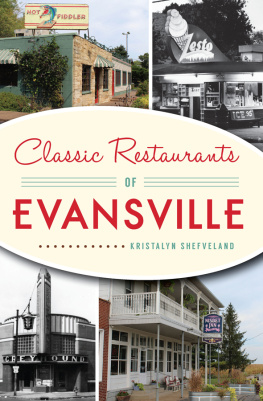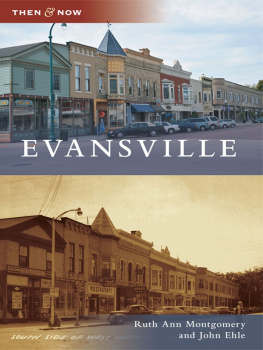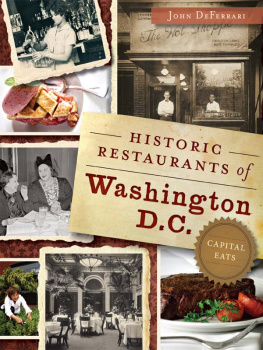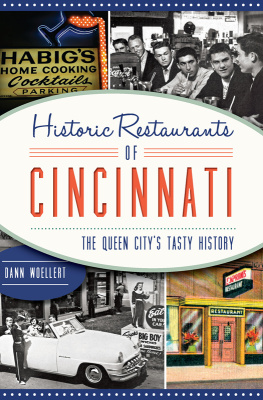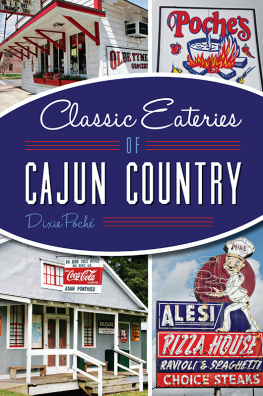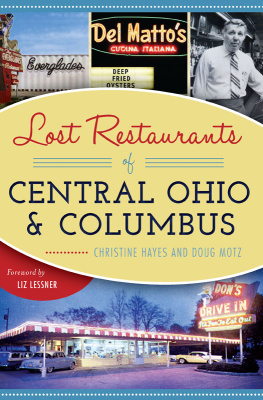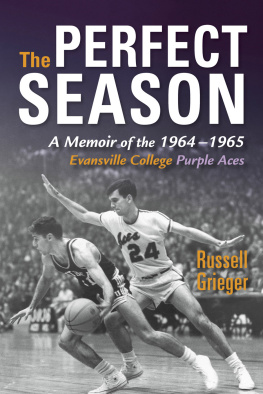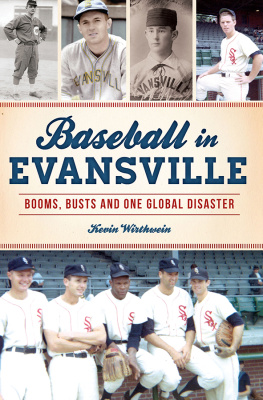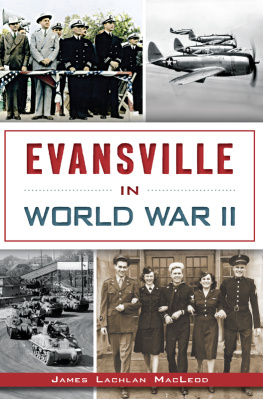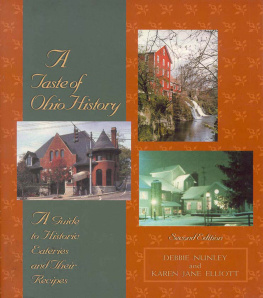
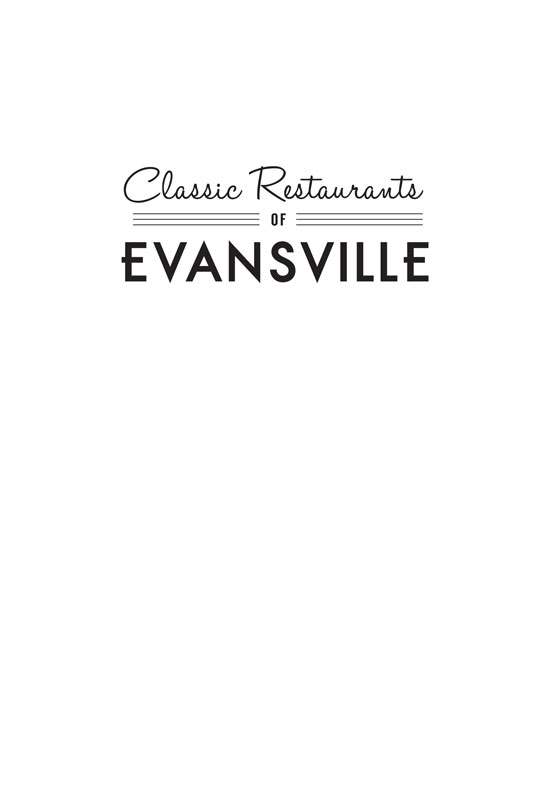

Published by American Palate
A Division of The History Press
Charleston, SC
www.historypress.com
Copyright 2020 by Kristalyn Shefveland
All rights reserved
First published 2020
E-book edition 2020
ISBN 978.1.43967.003.3
Library of Congress Control Number: 2020930485
print edition 978.1.46714.085.0
Notice: The information in this book is true and complete to the best of our knowledge. It is offered without guarantee on the part of the author or The History Press. The author and The History Press disclaim all liability in connection with the use of this book.
All rights reserved. No part of this book may be reproduced or transmitted in any form whatsoever without prior written permission from the publisher except in the case of brief quotations embodied in critical articles and reviews.
CONTENTS
Preface
How does a non-Evansville native come to write a history of Evansville restaurants, past and present? When I was a graduate student at the University of Mississippi, my parents would travel south from their home in a westside Cleveland suburb, stopping in Evansville as the halfway point to enjoy a meal downtown and to view the barges on the Ohio River. Many times, my Dad joked that Evansville had two colleges, and when I graduated, wouldnt it be great if I ended up there? As luck would have it, when I graduated in 2010, a position at the University of Southern Indiana opened and it happened to be in my areas of specialty. In the intervening years since then, I have had the joy of getting to know this community and met many fantastic folks who have shared their family stories, their love of the region and their passion for making Evansville a great community now and in the future. Encountering many personal histories and great stories, I often thought to myself, somebody should be saving these, and thus I created River Cities Oral History Project to collect those traditions and memories for future generations. Some of the people that Ive had the joy to get to know include Heather and Clint Vaught, entrepreneurs and visionaries for the renaissance of downtown Evansville, who shared, Weve been living and working in downtown Evansville since 2009, long before the redevelopment began. Ive had a love affair with downtown since I was in middle school; frequenting a coffee shop where I first learned how to pull a shot of espresso in the building next to our current location! When we got married and were offered the opportunity to live in the building next door, we jumped on it! We had dreamed of having a coffee shop down in the lower level of our building since 2009 but were twenty-one and it wasnt a realization endeavor. Fast-forward to 2016, and we found ourselves back in the building once again where I was opening a handmade, local gift shop. We decided that since downtown was void of coffee at the time that this was our chance! It was a normal integration, as we had groups of artisans and makers already meeting and creating in our shop to enhance our shop with more reasons for people to meet, create, sip and shop. In Classic Restaurants of Evansville, I hope to share some of the histories of these wonderful places and to further the conversation about the wonderful stories in the Tristate.
Acknowledgements
Research assistance on this project came from the University of Southern Indiana Rice Library Archives and Special Collections, Evansville Vanderburgh Public Library, the Vanderburgh County Historical Society and the Willard Library Archives and Special Collections. Jennifer Greene, archivist at the University of Southern Indiana, played a special role in collecting images for this project. Existing materials from Evansville Living and the Courier & Press databases have been instrumental in documenting the history of the restaurants in the region, and through the generosity of community members, oral histories conducted with the help of University of Southern Indiana history students as part of the River CitiesOral History Project brought to light many details of the rich stories of classic Evansville restaurants.
Introduction
Are you in a pickle, with so much on your plate, that you just cant figure where to have your next dinner or lunch date? Classic Restaurants ofEvansville can help. Nestled in a horseshoe bend along the Ohio River, Evansville finds itself in the border territory of the Midsouth and Midwest. This book considers the rich culinary traditions and foodways of the settlers of Evansville, Indiana, through the last two centuries. Evansville was founded in 1812 by Hugh McGary, who named the settlement after Colonel Robert M. Evans. Due to its location on the Ohio River and its abundant natural resources, Evansville has flourished over the last two centuries as the commercial, industrial, medical and financial hub of the Tristate region in this corner of southwest Indiana. By examining restaurants past and presentin images, recipes, food traditions and documentary evidencethis book highlights the rich history of Evansvilles food traditions and diverse culturefrom brain sandwiches to German traditions, cracker-crisp thin-crust pizza, Ski slushies, burgoo, doughnuts and more. In recent years, the area has experienced a revitalization movement in its historic districts through cafs, coffeehouses, and breweriesall hearkening back to Evansvilles past while embracing the foodie movements of the present and innovating for the future.
Its said we are what we eat, but folklorists believe that what we eat symbolizes who we are. Food is central to our identities, and its customs, beliefs, production, preparation techniques and materials, display objects, rituals and traditions are cultural artifacts called foodways. Restaurant history and foodways can teach larger lessons about culturegeography, history, herbal lore and folk medicine, natural resources, the built environment, economics, tourism, climatology, religion, adapting and adopting in a multicultural society, environmental sustainabilityand about tradition and change. Together, these topics can demonstrate how the family story, the community history and the significant events of humanity are regularly expressed through food, discovering the world through the types of regional food and the ways in which we connect to our past through them by the types of local restaurants that flourish in a region.
At its heart, this book is a story about Evansville and the places that evoke fond and colorful memories among its longtime residents, like Tom Kissel, whose father used to run a grocery store near the corner of Washington and Kentucky Avenues across from the famed Evans Cafe. In his recollection, I remember many of our fine, and not-so-fine Evansville restaurants growing up, and hearing about others that I never experienced. His father bought Emge Grocery and ran it until 1971, when they moved the store three blocks away to Adams and Evans. Kissel fondly recalled, I was eleven and clearly remember moving a grocery store, can-by-can. Many of the little confectioneries and hamburger stands are no longer in business, but a few remain, like the Burger Bank on South Weinbach and Covert, proving that a flat top and a fryer can go a long way and last several generations. And one simply should not forget the taverns. According to many residents of the Tristate, Evansville has the highest per capita number of taverns and churches to residents than any other region. While no scientific statistical study is available to date, anecdotally, the theory rings true. Each neighborhood has at least a tavern or two still in business and many, many more that have closed over the years. Those that remain have a long and storied history with family recipes and tall tales for generations to come. In fact, many of the bars in Evansville have multiple establishments within their walls, as in the 1980s and 1990s, several tavern owners made sure to save the physical attributes of closing establishments and bring them into the renovations of flourishing and expanding taverns and restaurants.
Next page
